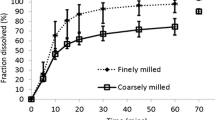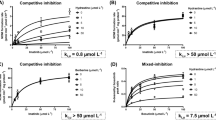Abstract
Background
Bitopertin (RG1678) is a glycine reuptake inhibitor currently in phase 3 trials for treatment of schizophrenia. This paper describes the use of physiologically based pharmacokinetic (PBPK) modelling and preclinical data to gain insights into and predict bitopertin clinical pharmacokinetics.
Methods
Simulations of pharmacokinetics were initiated early in the drug discovery stage by integrating physicochemical properties and in vitro measurements into a PBPK rat model. Comparison of pharmacokinetics predicted by PBPK modelling with those measured after intravenous and oral dosing in rats and monkeys showed a good match and thus increased confidence that a similar approach could be applied for human prediction. After comparison of predicted plasma concentrations with those measured after single oral doses in the first clinical study, the human model was refined and then applied to simulate multiple-dose pharmacokinetics.
Results
Clinical plasma concentrations measured were in good agreement with PBPK predictions. Predicted area under the plasma concentration–time curve (AUC) was within twofold of the observed mean values for all dose levels. Maximum plasma concentration (C max) at higher doses was well predicted but approximately twofold below observed values at the lower doses. A slightly less than dose-proportional increase in both AUC and C max was observed, and model simulations indicated that when the dose exceeded 50 mg, solubility limited the fraction of dose absorbed. Refinement of the absorption model with additional solubility and permeability measurements further improved the match of simulations to observed single-dose data. Simulated multiple-dose pharmacokinetics with the refined model were in good agreement with observed data.
Conclusions
Clinical pharmacokinetics of bitopertin can be well simulated with a mechanistic PBPK model. This model supports further clinical development and provides a valuable repository for pharmacokinetic knowledge gained about the molecule.





Similar content being viewed by others
References
Hyman SE. A glimmer of light for neuropsychiatric disorders. Nature. 2008;455(7215):890–3.
Tandon R, Nasrallah HA, Keshavan MS. Schizophrenia: “Just the Facts” 4: clinical features and conceptualization. Schizophr Res. 2009;110(1–3):1–23.
Thomas SP, Nandhra HS, Singh SP. Pharmacologic treatment of first-episode schizophrenia: a review of the literature. Prim Care Companion CNS Disord. 2012;14(1):PCC.11r01198.
Miyamoto S, Miyake N, Jarskog LF, et al. Pharmacological treatment of schizophrenia: a critical review of the pharmacology and clinical effects of current and future therapeutic agents. Mol Psychiatry. 2012;17(12):1206–27.
Javitt DC. Glutamate and schizophrenia: phencyclidine, N-methyl-d-aspartate receptors, and dopamine–glutamate interactions. Int Rev Neurobiol. 2007;78:69–108.
Javitt DC. Glycine transport inhibitors for the treatment of schizophrenia: symptom and disease modification. Curr Opin Drug Discov Devel. 2009;12(4):468–78.
Pinard E, Alanine A, Alberati D, et al. Selective GlyT1 Inhibitors: discovery of [4-(3-fluoro-5-trifluoromethylpyridin-2-yl)piperazin-1-yl][5-methanesulfonyl-2-((S)-2,2,2-trifluoro-1-methylethoxy)phenyl]methanone (RG1678), a promising novel medicine to treat schizophrenia. J Med Chem. 2012;53(12):4603–14.
Alberati D, Moreau JL, Lengyel J, et al. Glycine reuptake inhibitor RG1678: a pharmacologic characterization of an investigational agent for the treatment of schizophrenia. Neuropharmacology. 2012;62(2):1152–61.
Rowland M, Peck C, Tucker G. Physiologically-based pharmacokinetics in drug development and regulatory science. Annu Rev Pharmacol Toxicol. 2011;51:45–73.
Parrott N, Jones H, Paquereau N, et al. Application of full physiological models for pharmaceutical drug candidate selection and extrapolation of pharmacokinetics to man. Basic Clin Pharmacol Toxicol. 2005;96(3):193–9.
Parrott N, Paquereau N, Coassolo P, et al. An evaluation of the utility of physiologically based models of pharmacokinetics in early drug discovery. J Pharm Sci. 2005;94(10):2327–43.
Jones HM, Parrott N, Jorga K, et al. A novel strategy for physiologically based predictions of human pharmacokinetics. Clin Pharmacokinet. 2006;45(5):511–42.
Jones HM, Gardner IB, Collard WT, et al. Simulation of human intravenous and oral pharmacokinetics of 21 diverse compounds using physiologically based pharmacokinetic modelling. Clin Pharmacokinet. 2011;50(5):331–47.
Bjorkman S. Prediction of drug disposition in infants and children by means of physiologically based pharmacokinetic (PBPK) modelling: theophylline and midazolam as model drugs. Br J Clin Pharmacol. 2005;59(6):691–704.
Parrott N, Davies B, Hoffmann G, et al. Development of a physiologically based model for oseltamivir and simulation of pharmacokinetics in neonates and infants. Clin Pharmacokinet. 2011;50(9):613–23.
Edginton AN, Willmann S. Physiology-based simulations of a pathological condition: prediction of pharmacokinetics in patients with liver cirrhosis. Clin Pharmacokinet. 2008;47(11):743–52.
Rowland Yeo K, Aarabi M, Jamei M, et al. Modeling and predicting drug pharmacokinetics in patients with renal impairment. Expert Rev Clin Pharmacol. 2011:4(2):261–74.
Inoue S, Howgate EM, Rowland Yeo K, et al. Prediction of in vivo drug clearance from in vitro data. II: potential inter-ethnic differences. Xenobiotica. 2006;36(6):499–513.
Cubitt HE, Yeo KR, Howgate EM, et al. Sources of interindividual variability in IVIVE of clearance: an investigation into the prediction of benzodiazepine clearance using a mechanistic population-based pharmacokinetic model. Xenobiotica. 2011;41(8):623–38.
Kansy M, Avdeef A, Fischer H. Advances in screening for membrane permeability: high solution PAMPA for medicinal chemists. Drug Discov Today Technol. 2004;1(4):349–55.
Alsenz J, Haenel E. Development of a 7-day, 96-well Caco-2 permeability assay with high-throughput direct UV compound analysis. Pharm Res. 2003;20(12):1961–9.
Parrott N, Lave T. Applications of physiologically based absorption models in drug discovery and development. Mol Pharm. 2008;5(5):760–75.
Galia E, Nicolaides E, Horter D, et al. Evaluation of various dissolution media for predicting in vivo performance of class I and class II drugs. Pharm Res. 1998;15(5):698–705.
Poulin P, Theil FP. Prediction of pharmacokinetics prior to in vivo studies II. Generic physiologically based pharmacokinetic models of drug disposition. J Pharm Sci. 2002;91(5):1358–70.
Simulations Plus, Inc. Gastroplus 8.0 User Manual. Lancaster (CA): Simulations Plus, Inc.; 2012.
Zuegge J, Schneider G, Coassolo P, et al. Prediction of hepatic metabolic clearance: comparison and assessment of prediction models. Clin Pharmacokinet. 2001;40(7):553–63.
Poulin P, Theil FP. A priori prediction of tissue:plasma partition coefficients of drugs to facilitate the use of physiologically-based pharmacokinetic models in drug discovery. J Pharm Sci. 2000;89(1):16–35.
Agoram B, Woltosz WS, Bolger MB. Predicting the impact of physiological and biochemical processes on oral drug bioavailability. Adv Drug Deliv Rev. 2001;50(Suppl. 1):S41–67.
Davies B, Morris T. Physiological parameters in laboratory animals and humans. Pharm Res. 1993;10(7):1093–5.
Dressman JB, Amidon GL, Reppas C, et al. Dissolution testing as a prognostic tool for oral drug absorption: immediate release dosage forms. Pharm Res. 1998;15(1):11–22.
de Zwart LL, Rompelberg CJ, Sips AJ, et al. Anatomical and physiological differences between various species used in studies on the pharmacokinetics and toxicology of xenobiotics. A review of literature (online). Rijksinstitute voor Volksgezondheit en Milieu. 1999; RIVM report 623860 010. http://www.rivm.nl/bibliotheek/rapporten/623860010.html. Accessed 27 Sep 2012.
US Department of Health and Human Services, Food and Drug Administration, Center for Drug Evaluation and Research (CDER). Guidance for Industry. Estimating the maximum safe starting dose in initial clinical trials for therapeutics in adult healthy volunteers (online). http://www.fda.gov/downloads/Drugs/GuidanceComplianceRegulatoryInformation/Guidances/ucm078932.pdf. Accessed 27 Sep 2012.
Poulin P, Theil FP. Prediction of pharmacokinetics prior to in vivo studies. I. Mechanism-based prediction of volume of distribution. J Pharm Sci. 2002;91(1):129–56.
Jones HM, Parrott N, Ohlenbusch G, et al. Predicting pharmacokinetic food effects using biorelevant solubility media and physiologically based modelling. Clin Pharmacokinet. 2006;45(12):1213–26.
Pajouhesh H, Lenz GR. Medicinal chemical properties of successful central nervous system drugs. NeuroRX. 2005;2(4):541–53.
Berezhkovskiy LM. Volume of distribution at steady state for a linear pharmacokinetic system with peripheral elimination. J Pharm Sci. 2004;93(6):1628–40.
Rodgers T, Rowland M. Physiologically based pharmacokinetic modelling 2: predicting the tissue distribution of acids, very weak bases, neutrals and zwitterions. J Pharm Sci. 2006;95(6):1238–57.
Parrott N, Lavé T. Prediction of intestinal absorption: comparative assessment of GASTROPLUS and IDEA. Eur J Pharm Sci. 2002;17:51–61.
Sutton SC. Role of physiological intestinal water in oral absorption. AAPS. 2009;11(2):277–85.
Hofmann C, Banken B, Hahn M, et al. Evaluation of the effects of bitopertin (RG1678) on cardiac repolarization: a thorough QTc study in healthy male volunteers. Clin Ther (in press).
Zhao P, Rowland M, Huang SM. Best practice in the use of physiologically based pharmacokinetic modeling and simulation to address clinical pharmacology regulatory questions. Clin Pharmacol Ther. 2012;92(1):17–20.
Parrott N, Lukacova V, Fraczkiewicz G, et al. Predicting pharmacokinetics of drugs using physiologically based modeling—application to food effects. AAPS. 2009;11(1):45–53.
Jamei M, Dickinson GL, Rostami-Hodjegan A. A framework for assessing inter-individual variability in pharmacokinetics using virtual human populations and integrating general knowledge of physical chemistry, biology, anatomy, physiology and genetics: a tale of ‘bottom-up’ vs ‘top-down’ recognition of covariates. Drug Metab Pharmacokinet. 2009;24(1):53–75.
Heikkinen AT, Baneyx G, Caruso A, et al. Application of PBPK modeling to predict human intestinal metabolism of CYP3A substrates—an evaluation and case study using GastroPlus™. Eur J Pharm Sci. 2012;47:375–86.
Lukacova V, Parrott NJ, Lave T, et al. General approach to calculation of tissue:plasma partition coefficients for physiologically based pharmacokinetic (PBPK) modeling [poster no. M1312]. AAPS 2008. http://abstracts.aaps.org/SecureView/AAPSJournal/110icn06qg7ckm1ggkh1.pdf. Accessed 26 Mar 2013.
De Buck SS, Sinha VK, Fenu LA, et al. The prediction of drug metabolism, tissue distribution, and bioavailability of 50 structurally diverse compounds in rat using mechanism-based absorption, distribution, and metabolism prediction tools. Drug Metab Dispos. 2007;35(4):649–59.
Jones HM, Gardner IB, Collard WT, et al. Simulation of human intravenous and oral pharmacokinetics of 21 diverse compounds using physiologically based pharmacokinetic modelling. Clin Pharmacokinet. 2011;50(5):331–47.
Heikkinen AT, Friedlein A, Lamerz J, et al. Mass Spectrometry based quantification of CYP enzymes to establish in vitro-in vivo scaling factors for intestinal and hepatic metabolism in beagle dog. Pharm Res. 2012;29(7):1832–42. doi:10.1007/s11095-012-0707-7.
Rostami-Hodjegan A, Tucker GT. Simulation and prediction of in vivo drug metabolism in human populations from in vitro data. Nat Rev Drug Discov. 2007;6(2):140–8.
Baneyx G, Fukushima Y, Parrott N. Use of physiologically based pharmacokinetic modeling for assessment of drug–drug interactions. Future Med Chem. 2012;4(5):681–93.
Howgate EM, Rowland-Yeo K, Proctor NJ, et al. Prediction of in vivo drug clearance from in vitro data. I: impact of inter-individual variability. Xenobiotica. 2006;36(6):473–97.
Johnson TN, Rostami-Hodjegan A, Tucker GT. Prediction of the clearance of eleven drugs and associated variability in neonates, infants and children. Clin Pharmacokinet. 2006;45(9):931–56.
Acknowledgments
This study was funded by F. Hoffmann-La Roche. All authors were employees of F. Hoffmann-La Roche when this work was carried out. They have no other conflicts of interest to declare.
Author contribution
Participated in research design: Parrott, Hainzl, Martin-Facklam, Boutouyrie, Alberati. Conducted experiments: Hainzl, Alberati, Martin-Facklam, Boutouyrie, Hofmann, Robson. Performed data analysis: Parrott, Hofmann. Wrote or contributed to writing the manuscript: Parrott, Martin-Facklam. Reviewed manuscript drafts and approved final version for submission: Parrott, Hainzl, Alberati, Hoffmann, Robson, Boutouyrie, and Martin-Facklam.
Author information
Authors and Affiliations
Corresponding author
Electronic supplementary material
Below is the link to the electronic supplementary material.
Rights and permissions
About this article
Cite this article
Parrott, N., Hainzl, D., Alberati, D. et al. Physiologically Based Pharmacokinetic Modelling to Predict Single- and Multiple-Dose Human Pharmacokinetics of Bitopertin. Clin Pharmacokinet 52, 673–683 (2013). https://doi.org/10.1007/s40262-013-0061-x
Published:
Issue Date:
DOI: https://doi.org/10.1007/s40262-013-0061-x




